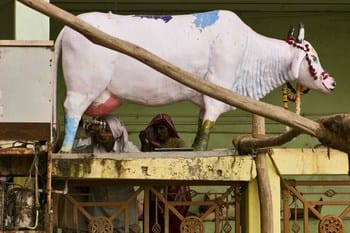Religious faith in a country like India is not a matter to be trifled with. If it doesn’t actively move mountains, it does manage to move millions in population- physically and emotionally. India’s multireligious identity provides for its secular political outlook, one that is questioned and turned upside down everytime communal tensions take over the public psyche. But we have to just look around us to see the things people d,o to assist their relationship with the divine. Fawzan Husain has done just that; in his exhibition of photographs at Tasveer, Kasturba Cross Road. He successfully captures the essence of religious experience in its most palpable moments. The exhibition is on till February 13th.

One of the photographs on display. Pic: Fawzan Husain.
Husian has more than twenty years behind him as a professional photographer, working as a news photographer and pursuing his personal projects more or less simultaneously. His personal journey has taken him around India, into different cultural spaces, documenting images of the magical connection between people and their religion.
The images are evocative, and very easy to connect with. The subject matter moves between extremes: in some, like the women devotees sprinkling coloured water at male members of the family at Dauji Temple in Uttar Pradesh, and the Osho followers swaying wildly in a trance, there is an element of high drama, action and frenzy, while in others, like the picture of a widow at Brindavan singing praises to Lord Krishna, and the serene interior of a Buddhist temple in Leh, with a young Lama entering in awe, there is a calm inwardness.
Whether in hysterical crowds or quiet spaces, Husain manages to keep his intervention invisible while capturing candid shots. The greatest challenge of documentary photographers whose canvas is real life environment is the balance of the private and public; to enter into personal and collective space, and shoot images that maintain the boundaries in a respectful way. Husain seems to have struck the right balance.

Pic: Fawzan Husain
One image in the exhibition shows devotees of mixed religious backgrounds stretching their hands to touch and offer coins at the feet of a statue of Jesus Christ, another frames arms reaching out for the blessings of Lord Jagannath; yet another has a young Brahmin boy, his arms held apart by others during the thread ceremony. Husain has followed gestures and body movements, the outwardly attributes of the faithful. A spontaneous eye for detail, a sensitive understanding of colour, and an absolute sense of rightness in framing the compositions, and a recognition and utilisation of ‘chance’, all contribute towards the completeness of every image in the show.
An endearing quality of Husain’s work is his ability to introduce humour and satire into his bodies of work. Though he never strays from using his photographic practice to make critical social observations, the incidental light-heartedness adds a quality of human emotion that achieves instantaneous communication with viewers.
Sua House, 26/1 Kasturba Cross Road
Ph: 2212 8358
In his current series, there is a fair share of this – an example being the ingenious cow-shaped-tank with taps, for pilgrims to drink water from, and another where a clever focusing of the background and foreground brings together two disparate items (in this case a stretched thread, and a figure jumping respectively) and creates a spectacle of the figure tightrope-walking!
Turning forty years old, or forty years young, as the case may be, caused Husain to relook his experiences, mull on performing the Hajj pilgrimage, think of life’s philosophies, righting wrongs and bettering life. In looking into little matters of how faith changes the living, he hits upon the subject that would occupy him for almost the next two years. The exhibition is a result of that exploration.⊕